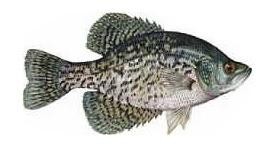Freshwater Fish B
Freshwater Fish - B
▲Black Crappie
((Pomoxis nigromaculatus) papermouth, Calico bass, specks, speckled perch)
◎White. The black crappie is covered with dark, irregular blotches and has sevenırarely eightıdorsal spines. It shows more yellowish and greenish on its sides and its caudal (tail) and anal fins are heavily flecked.
▲Blueback Herring
((Alosa aestivalis) river herring)
◎Blueback herring and alewife are almost identical looking; the best way to tell them apart is an internal difference, blueback have a black membrane that lines the abdominal cavity and alewife have a light colored one with few, scattered spots. Blueback are bluish along the back with a silvery head; alewife is grayish- blue above, with a bronze head.
◎Size: Maximum length is 12 to 15 inches and less than 1 lb.
▲Bluegill
((Lepomis macrochirus) Bream, bluegill sunfish, sun perch)
◎Colors are variable. Dark green, olive-green, olive brown, or bluish-black on its back, fading to yellowish- green or silvery. Normally has five to seven vertical bars extending down on each side. Lower parts of its cheek and gill cover are bluish. Its ıthroatı is yellow on females to bright orange on the male, brighter during spawning. Has a black, ear-like flap on its opercle (gill cover) and a black blotch at the back base of its spiny dorsal fin. Typically under 1lb. in Virginia.
▲Brook Trout
((Salvelinus fontinalis) native, brookie, mountain trout, speckled trout)
◎Most colorful of our trout. Back is a dark olivegreen with light wavy or wormy markings.Sides are lighter, sometimes with a bluish cast, yellowish spots and red spots with a light blue halo around them. Belly is white with bright orange fins. Fins have outer edges of white with a black line separating it from the orange. Ten to 16 inches and 1 to 2 lbs. is a good-sized brookie.
◎Size: Native brookies seldom grow beyond 12 inches in Virginia streams.
▲Brown Trout
((Salmo trutta) English brown trout, German brown trout, European trout)
◎Colors vary widely. Natural wild browns are olivebrown on the back, lighter on the sides, brilliant yellow-gold on their underside, with yellowish-green, unspotted fins. They have numerous black or dark brown spots on their sides, along with a sprinkling of red spots encircled with light blue rings. Hatchery-reared browns tend to be more silvery with dark brownish above with light yellow undersides and spots of a lighter shade.
▲ Bowfin
◎Bowfin are living relics, with primitive roots back 70 million years ago. Has a long, softrayed dorsal which arches in a bow over most of the length of its body. Tail is rounded, with distinct black spot rimmed with orange on males; black spot on females faint or absent and no orange rim. Its back and sides are brownish-green or olive-green, with mottled sides fading to yellowish or white. During spawning, its underside turns a bright yellow-green. Body is cylindrical and a wide flattened head, almost snake-like, with deepset dark eyes. Snout is rounded with short nasal barbels. Mouth is large and has conical-shaped teeth.
◎Note: While the bowfin shares similar coloration and body shape with the northern snakehead (recently introduced to the Potomac River), the anal fin of a bowfin is much shorter than that of the snakehead, and snakeheads will not have the spot found on bowfin.
▲Blue Catfish
((Ictalurus furcatus) forked-tailed cat, humpback blue, chucklehead)
◎ Heavy-bodied with a wide head and high spot forward of center near the head called the dorsal hump. Upper jaw projects well beyond the lower. Bluish-gray body above, fading to white on sides and belly. No spots and a deeply forked tail. Smaller blue cats are often confused with channel catfish. Blue cats are often confused with channel catfish. Small channel cats typically will have spots lacking in small blue cats. However, large channel cats and medium-sized blue cats can be more difficult to tell apart, often having similar coloration and general body shape. The margin, or edge, of the anal fin can be used to identify these fish; blue cats have an anal fin with a very straight margin, in channel cats the anal fin has a rounded margin. Biologists and anglers can definitively distinguish between the two species by counting anal fin rays;30-35 rays on the blue catıs anal fin verses the channel catıs 25 to 29 rays.






